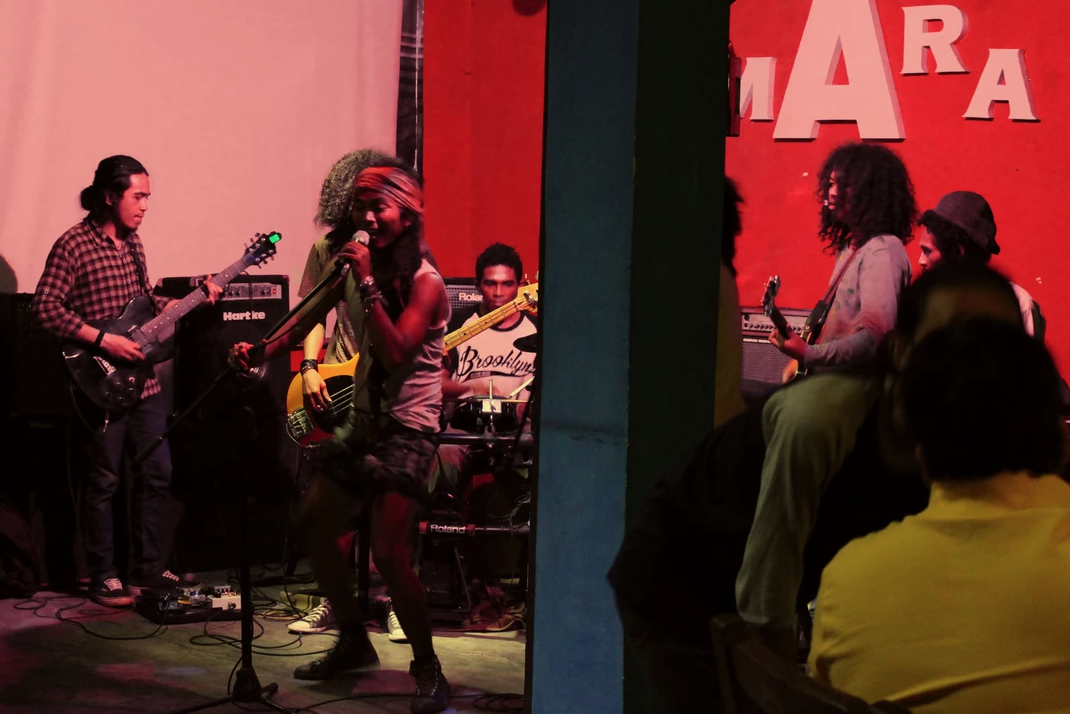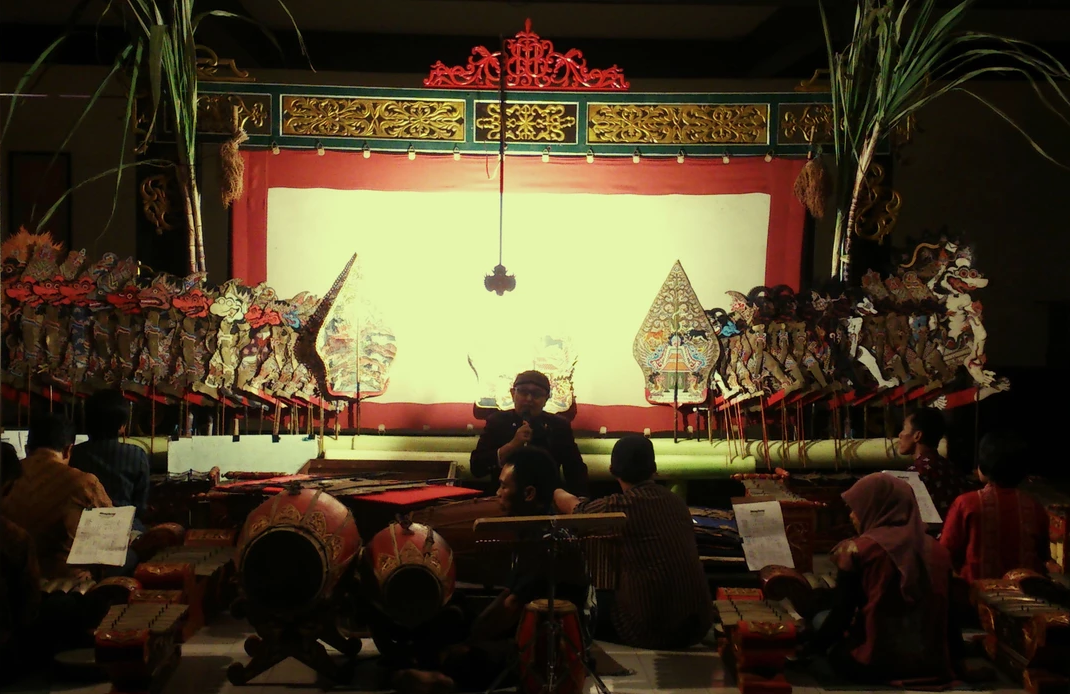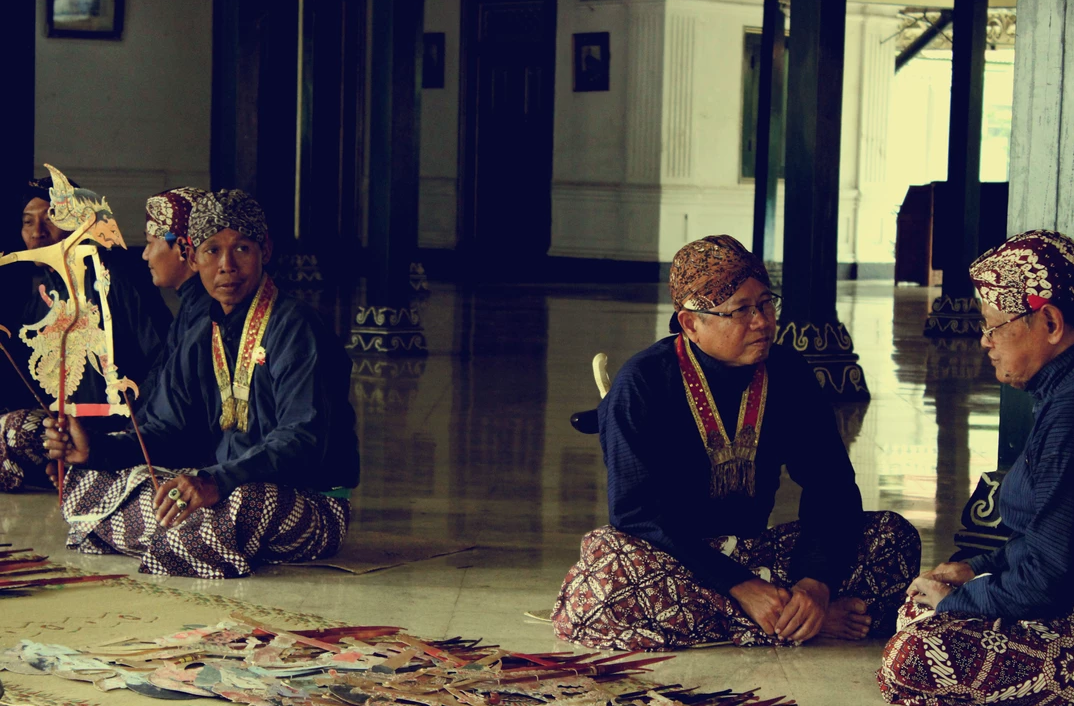Seeking the Margins: Stories Within and Beyond Jogja
By Ruby Saha ‘14, Gadjah Mada University (2014-2016)
Saturday night; it’s early still. The band was supposed to play thirty minutes ago, but the stereo carries on blasting eighties hits to an empty bar. Dim bluish lights play across the curved spines of servers slumped over the bar with only a few faded Marley posters for company. Paper bats flap lazily in the hazy corners, lingering remnants from Halloween half a year ago.
My friend Zirro’s band Remang, from Nusa Tenggara Timur, performing on Saturday night at Lucifer.
I’ve been to Lucifer enough times to know that it’s a ghost town before ten, because arriving anywhere on time here is an exercise in futility. I do it because it’s fun to watch this dusty bar come alive after dark, first with people and then beer bottles and cigarette smoke, languidly filling up and then spilling outwards onto the street corner. I’m reminded of a scene from a Miyazaki film, Spirited Away, where the empty spaces of an eerily silent, abandoned carnival town rouse to life after dusk, filling to the brim with a great host of lively spirits hungry for a good soak in the bathhouse.
There’s live music every night at Lucifer. On Saturday nights, it’s reggae, and by the time the band has climbed onstage there’s hardly room to breathe, let alone move. Fans crowd the narrow space between the stage and the tables, dancing to the steady swagger of classic Marley hits like “Get Up, Stand Up” and “No Woman No Cry”, as well as more contemporary tunes like “Rude”. Everyone sings along to the music, and even if the playlist feels repetitive and the sound can be painfully loud in the tiny dive bar’s non-existent acoustics, there’s a strong sense of community here that’s vibrant, youthful and fun.
Reggae band performing on Thursday night at Asmara on Jalan Tirtodipuran.
Bars like Lucifer, Asmara, Tonk and Bintang Café have a steady roster of reggae acts; on any given week you could listen to the same band play at three or four different venues, should you feel so inclined. Most of these places are located in the tourist enclaves of Jogja, with street names that twist around the tongue: Sosrowijayan, Prawirotaman, Tirtodipuran. As in Bali, where reggae reached the height of its popularity in the early nineties in beach towns like Kuta, Jogja’s reggae scene is well-attended by bules—tourists and foreign residents alike—in search of cheap beer and live music.
But while Jogja may be the cultural heartland of Java, its reggae scene seems largely and distinctly devoid of a Javanese presence. All of the reggae artists I’ve seen here hail from the islands to the east of Java—mainly the Nusa Tenggara islands, which along with Sulawesi, Maluku and Papua are collectively (and often derogatorily) dubbed “Timur”, or East. Bands like Remang, Marapu and Black Finit from Nusa Tenggara and Rasta MOF dominate the Jogja scene, and fellow eastern islanders (“orang Timur”) are their primary audience. On any given reggae night, I find myself weaving through a crowd of dreadlocked Manggarai men and short-skirted Papuan women whose Pacific Islander features and mother tongues differ noticeably from the ethnic Javanese majority.
I don’t mean to imply that Javanese folks never indulge in reggae. My first introduction to reggae was through my Javanese friends, who like many others are regulars at these events. Like the rest of the crowd, they might enjoy a few beers, support their friends’ bands, sing along to the best of Bob Marley and work up a sweat on the dance floor. And there are plenty of Javanese reggae-themed acts; some have even achieved national recognition, like the popular Jogja-based band Shaggy Dog.
But in Jogja, where the Javanese population represents a near-total majority, it’s exceedingly rare to bump shoulders with so many orang Timurin one space. Indeed, the reggae scene is one of the few safe spaces for these minority communities, who are largely marginalised here and tend to live on the fringes of the city. Considering its history of covert social critique, I’m not surprised that it should be reggae music that creates a common space for Timur people living in Jogja. Many of my Timur friends identify strongly with the political consciousness that underpins reggae’s lyrical themes, and indeed the reggae movement at large.
I begin this narrative with the reggae scene mainly because, without it, mynarrative as a Shansi fellow in Indonesia would be a primarily Javanese one. In the English department at Universitas Gadjah Mada, the faculty and students alike are nearly all Javanese, often from the Yogyakarta region if not the city itself. Everyone I interact with in my day-to-day activities, from my laundry ladies to the baristas at the cafés where I work, from the ibu that runs my favourite food stall to the bapak that fixes my motorbike, is Javanese. At Alam Bahasa, where we first begin our fellowship as language learners, nearly all the teachers are Javanese, and everything from the vocabulary we learn to the accent we hear around us has a distinctly Javanese inflection.
Javanese society is highly structured—a tip of the hat, I suspect, to the lingering Hindu influence. Bahasa Jawa has at least three different registers with distinct vocabularies: kromo in formal contexts, ngoko among friends and family or towards those of a lower social status, and the lesser-usedmadyo for the realm of social ambiguity. In the common room, our colleagues converse in Javanese, frequently switching between registers, or to Indonesian or English to speak to Julie or me. My friends and students talk to each other in ngoko, leaving me to parse out what little I’ve picked up in the last year. (In truth I’ve learned more than I let on, but my accent is abominable and anyway, it’s always fun to eavesdrop.) Taxi drivers seem to derive particular pleasure in saying sentences in Javanese just to hear my sheepish response: ora iso boso jowo. I can’t Javanese. Cue delighted laughter. Rinse and repeat.
dramatic scene from the beautiful and elegant retelling of the Ramayana epic against the striking backdrop of the Hindu temples at Prambanan
But, humour aside, I’m uniquely privileged to have such access to the richness of Javanese culture in its beautifully sophisticated forms, here at the very heart of it all. In less than a year, I’ve had the pleasure of enjoying the poised, elegantly meditative pace of Javanese gamelan and dance, particularly the sumptuous ballet production of the Ramayana epic. I’ve fallen in love with and often spend an unholy chunk of my stipend on batik, learning to recognise regional forms and colours. I’m fascinated by the exquisite art forms of wayang kulit, shadow puppets fashioned from finely tooled leather. I spend much of my time picking apart the palimpsest of religions and cultures that have left their mark on Jogja, journeying to the edges of the city in search of the remains of medieval Hindu and Buddhist temples tucked away in the green hills.
Within this context it becomes easy, after a while, to map my experience of Javanese culture onto the image of Indonesian culture at large. Like every newly independent, heterogeneous nation-state, cultural unity is one of Indonesia’s primary concerns, and with over three hundred different ethnic groups spread across 17,000 islands, this is no small feat. Javanese is the dominant ethnicity in Indonesia, accounting for nearly half its population. Java has been the seat of power in the archipelago for centuries, even during colonial occupations, and the Javanese have always represented the political majority. Despite what The West Wing might tell you, there has never been a non-Javanese president (and Indonesian is definitely a language, thank you very much Donna.)
Universitas Gadjah Mada, where my teaching (mis)adventures as a Shansi fellow take place, is the oldest, largest, and easily the most prestigious public institution of higher education in Indonesia. I garner a great amount of undeserved respect as an UGM lecturer, particularly for my age; often people will immediately change their pronoun use and manner upon discovering my job title. Like an Ivy League education, a degree from UGM is a highly respected qualification and greatly sought after as a portal for better job prospects, especially in politics, economics and medicine. Admission to UGM is extremely selective at the undergraduate level; students are accepted largely based on their performance on the national examinations at the end of the year. Hundreds of thousands of students apply across the archipelago each year, and just a few thousand are selected. This year’s acceptance rate was five percent, matching record lows for Harvard and Stanford; Oxford’s was eighteen percent.
Pak Eddy leads an English language wayang show in collaboration with students from the Sastra Inggris gamelan group Prasasti and students from the National University of Singapore, who are trying out gamelan for the first time
Dalangs (puppet masters) displaying handmade shadow puppets at the Sultan’s Palace in Jogja
Through conversations with friends and colleagues, I’ve come to realise that it’s no accident that most of my students—and, indeed, most of the undergraduate students at public universities here—are Javanese. Out of the forty-odd students in my freshman class at UGM, just two are from Bali. A few are from Jakarta; particularly those in the international program for students whose schools did not follow the national examination curriculum. But the great majority of them hail from Yogyakarta and its surrounding regencies—mainly Magelang, Bantul, and Klaten. There are no students from Aceh or Timur in my undergraduate classes.
The Balinese community in Jogja celebrates Melasti, the purification ceremony before Nyepi or Balinese Hindu New Year, at Parangkusumo Beach
It took a long time for me to notice this trend, even longer to find it odd. From the beginning I had noticed that the average person in Jogja seemed to be unusually well educated, even for a university town. Education is free and compulsory in Indonesia until junior high school and primary enrolment is nearly universal, but most people I’ve met here have graduated high school, and many have a tertiary diploma, if not a degree. On paper, Java has the largest low-income population in Indonesia and much of the island is rural and poor. Yet, education infrastructure, access and resource allocation are all much greater here and in Bali than anywhere else in the archipelago, and the Javanese have higher rates of post-primary enrollment than any other Indonesian ethnic group.
By contrast, poverty is disproportionately concentrated in the eastern islands. Much of Timur is extremely remote, limiting access beyond the primary school level and adding to the financial burden of post-primary education for rural families, who benefit more from using their children as an additional source of income than spending money on transport costs. For the few who are able to attend school, resource shortages are common and qualified teachers are not. Even procuring textbooks has been a frequent issue across the region. Students get only one chance to pass the national exams, and with conditions like these it’s little wonder that so many Timur kids don’t. Of the few who do make it to higher education, many find it difficult to compete and ultimately don’t graduate. The dropout rate for Timur students is high and job opportunities for them are few. Music is one of the few sources of income available to the less educated, which does much to explain the demographic of the reggae scene here, where I first befriended Timur musicians whose stories followed a strikingly similar path.
We often think of cultural assimilation as the process of navigating dissonance between national lines. But while as bules we may struggle with and feel alienated by many facets of Indonesian culture, we enjoy a great amount of cultural capital here that Indonesians from outside Java do not. One of the more insidious side effects of systemic inequality here, like anywhere else, is the way in which it produces and reifies negative perceptions between groups in a way that is inextricably tied to ethnic power dynamics. Much like its dance form, Javanese culture emphasises a polite, soft-spoken and careful demeanour; loud or violent expressions of emotions are deeply frowned upon. And, of course, alcohol is prohibited in Muslim culture, whereas, due to the Portuguese colonial influence further east, most Timur people are Christian or Catholic. Even amongst the most educated people I have met, perceptions of orang Timur as drunk, lazy, corrupt and violent are deep-rooted.
Encountering Java everywhere I go, even Javanese Super Mario in Kuta, Lombok, Nusa Tenggara Timur.
A few weeks ago, I introduced my students to one of my favourite TEDTalks by Nigerian writer Chimamanda Ngozi Adichie, “The Danger of a Single Story”, where she describes the way Africa has become essentialised to a single, reductive narrative of poverty, corruption and devastation in most people’s imaginations. I asked my class to think of some single stories or stereotypes that exist within Indonesia and describe one or two of them. Here are a few excerpts:
People often assume that Maduranese are bad tempered, emotional, and easily offended. …There are some evidences that indicates this society is bad tempered. First, this ethnic’s symbol is a sickle. This sickle is also used as a weapon. And it’s somehow like symbolizing the emotional sense of this society. Besides, this society use a “sickle war” as the problem solving among families. And sometimes it sacrifices a soul and a lot of victims fall.
Javanese people mostly think that Batak people are scary because of the way they talk. They have loud voice and sometimes they sound angry while they are talking.
Dayak people are said to be obsessed with Javanese people. They would do anything to be able to marry them, but if they get rejected, they will use their black magic to torture them and even brainwash or kill them.
Many of my students wrote about meeting people from Kalimantan and Timur for the first time in Jogja. Most of my students have never left Central Java, because travel is largely inaccessible to them. They live in dormitories with other Javanese students, with curfews that do not allow them to attend late night events like reggae nights. When I asked them to think of ways in which we might combat these stereotypes and challenge these single stories, many suggested that we try to interact with these people and understand them on a human level.
As a foreigner, I can only encourage my students to engage critically with the narratives that they have grown up hearing, to help them unpack the stereotypes they encounter and discuss how they might expand their perceptions of others. If I’ve learned anything in my year as a teacher here, it’s that it is not my place to preach to them about what I perceive to be right or wrong; they are intelligent and thoughtful young people who, with a little gentle nudging, are perfectly capable of figuring it out themselves.
But as a Shansi fellow, within the context of cross-cultural discourse that we carry with us throughout our time here, I think we, I, should appreciate and participate in the culture that surrounds us, but also seek out the limits and margins of these spaces, which is a freedom that our students do not often have. I’m extraordinarily grateful to have the opportunity to be here for another year, and I’d like to spend that time finding and listening to the stories of the people I encounter, whether it’s in the classroom or a reggae bar or a roadside stall. As Adichie beautifully put it, “stories matter. Many stories matter. Stories have been used to dispossess and to malign, but stories can also be used to empower and to humanise. Stories can break the dignity of a people, but stories can also repair that broken dignity.” I’d like to continue to seek out these stories: the stories that empower and humanise, but also the stories that dispossess and malign, because they too form a part of the larger, richer anthology of Indonesia.








